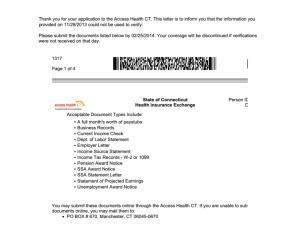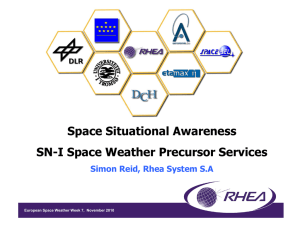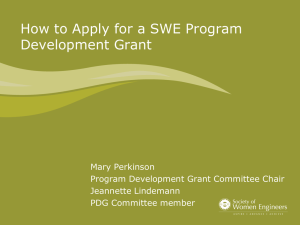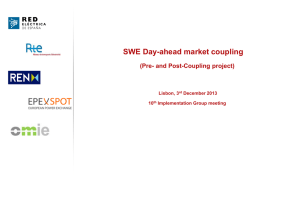Juha-Pekka Luntama
advertisement
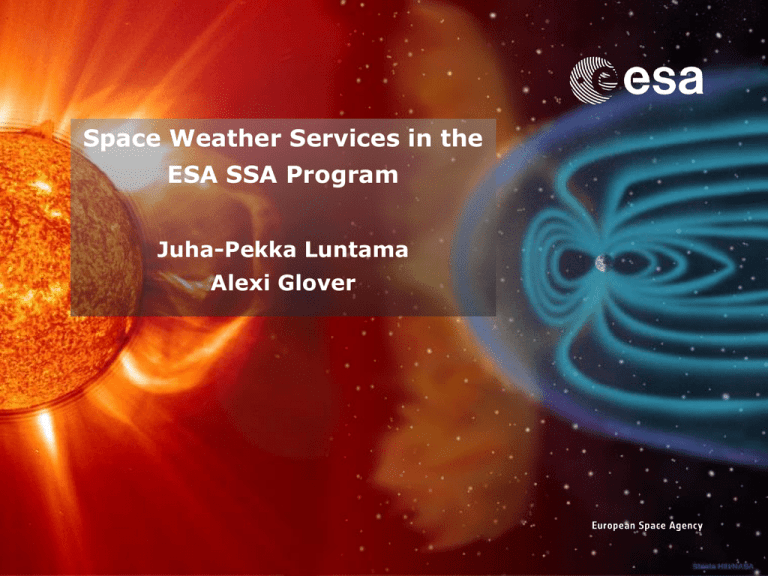
Space Weather Services in the ESA SSA Program Juha-Pekka Luntama Alexi Glover ESA SSA Programme Objective: • To support independent European utilisation of and access to space for research or services, through the provision of data, information and services regarding the near-Earth space environment. This includes the identification of threats and support for the sustainable exploitation of space. High level user requirements: • Support safe and secured operation of space assets and related services • Support risk management (on orbit and during re-entry) and liability assessment • Assess the status and basic characteristics of space objects (both human-made and natural) • Detect non-compliance with applicable international treaties and recommendations • Enable the allocation of responsibility for space objects to launching State or Organisation and support confidence building measures (identification of owner and/or operator) European SSA System Surveillance and Tracking • Maintain Catalogue of Man-made Objects in Earth Orbit • Detection, Tracking, Correlation and Characterisation of all objects above a given size threshold for a given orbit region • Covers Low Earth Orbit (LEO), Medium Earth Orbit (MEO) and Geostationary (GEO) Orbits • Prediction and Warning of Collisions and Re-Entry Events • Detection of on-orbit Explosions, Collisions and Manoeuvres Space Weather • Detection and Forecasting of Space Weather and its Effects • Monitoring of the Sun, Solar Wind, Radiation Belts, Magnetosphere and Ionosphere • Support Services relating to effects, including: Radiation and Spacecraft Charging hazards; Spacecraft Drag; Ionospheric Perturbations; Aircraft Radiation hazards; Geomagnetic Disturbances; and current induced in large conductive networks, such as power lines and pipelines. • Statistical Monitoring of Micro-particles of natural or human origin. Near Earth Objects (NEOs) • Solar System objects with orbits that bring them into close proximity with the Earth • Includes a few thousand Near Earth Asteroids; Near Earth Comets; Solar Orbiting Spacecraft; and larger Meteoroids • Objects >2m diameter to be Tracked • Determination of Orbit State and Physical Parameters • Identification and Ranking of NEO Collision Risks with Earth SSA SWE Objectives Detection and forecasting of the Space Weather events and the effects it has on European space assets and ground based infrastructure: • Comprehensive knowledge, understanding and maintained awareness of the natural space environment • Detection and forecasting of SWE and its effects • Detection and understanding of interferences due to SWE • prediction and/or detection of permanent or temporary disruption of mission and/or service capabilities • provision of predicted local spacecraft and launcher radiation, plasma and electromagnetic environment data images: (ESA & NASA) SSA SWE User Domains and Planned Services 1. Spacecraft designers • Environment specification and post event analysis 2. Spacecraft operators • In orbit environment and effects monitoring/forecasting, post event analysis, mission analysis 3. Human space flights • In flight and cumulative crew radiation exposure, increased crew radiation exposure risk 4. Launch operators • In flight monitoring, estimates and forecasts of radiation effects in electronics, atmospheric density forecasts 5. Transionospheric radio link users • Real-time and forecast TEC maps, scintillation maps, ionospheric disturbances monitoring 6. Survey and tracking • Atmospheric estimates, geomagnetic and solar indices archives and forecast for drag calculation 7. Data services • Space weather data archive, event based alarms 8. Non Space Systems Operators • Power systems and pipeline operators, airlines, resource exploitation system operators, auroral tourism sector SSA SWE Precursor Services • A subset of SSA SWE services to be established in Q3 2010 • These services are based on existing applications and services • The applications owned by ESA will be part of the precursor services: Space Environment Data System (SEDAT) European Impact Detector Database (EDID) Space Environment Information System (SPENVIS) Standard Radiation Environment Monitors (SREM) Space Weather European Service Network (SWENET) portal Space Environment System for Operations (SEISOP) Ionospheric Monitoring Facility (IONMON) • The rest of the precursor services will be selected in an activity to be started in June 2010 SSA Exploitation of Existing Assets SSA SWE Users Coordination elements SWE Service Coordination Centre SWE Data Centre (server) Federated elements Service Operation Team (Coordination of the Services) SWE Expert Service Centre SWE Expert Service Centre SWE Expert Service Centre Coordinating expert group Coordinating expert group Coordinating expert group Expert group Local customers Expert group Expert group Local customers Data SSA SWE Space Segment In June 2010 an activity will be started to define: • the SWE instruments needed to satisfy our customer requirements • the required satellite orbits for the measurements • the characteristics of the instruments and the planned satellite mission for suitable orbits • spacecraft that could be adapted for a dedicated missions SSA SWE Spaceborne Instrumentation SWE Instrument types to be addressed • X/EUV imager • X-ray flux monitor • UV flux monitor • Wide Angle Coronagraph • 3D Magnetometer • Solar wind plasma monitor • Plasma spectrometer and (Langmuir) density probe. • Medium energy particle detector • Compact Radiation Monitor • High energy particle spectrometer • GNSS dual frequency receiver in radio-occultation mode • Micro-particle detector Summary • SSA Preparatory Programme has been started in 2009 • The objective of the Preparatory Programme is to establish initial precursors services in 2010 • User driven approach for the services => Customer requirements specified by SSA User Representative Group (URG) • The initial precursor services in the SSA SWE Segment are based on existing services already in operational environment • The SSA SWE Segment is developed by exploiting the European expertise in the space weather area under the coordination of ESA

